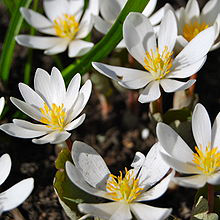Description
Blood Root: Sanguinaria canadensis,
Other Names: Coon root, Indian paint, Red Puccoon, Red root, Tetterwort
Country of Origin: United States.
The nickname, bloodroot, came about because of the red sap that would "bleed" from the roots of the flower. Many tribes used it as a dye for clothing, baskets, and face paint. Other parts of the flower were also used to create orange and yellow dyes as well. At one point, it was even imported by the French for use as a coloring agent on wool.
Bloodroot was used by eastern American Indian tribes as a red dye and in the treatment of ulcers, skin conditions, and as a blood purifier as well as for treating ulcers and skin conditions. All of these medicinal uses derive from the appearance of the blood-red latex exuded from the fresh root. The juice also was used for coughs and sore throats, with the bitter taste masked by placing the juice on a lump of maple sugar that was then sucked. Higher oral doses were observed to expel phlegm and cause vomiting.
The root entered 19th century medicine as a caustic topical treatment for skin cancers, polyps, and warts. Bloodroot has been marketed in toothpastes and mouthwashes for the prevention of gum disease and plaque, but studies have found it inferior to drugs such as doxycycline and chlorhexidine, with concerns about its toxicity.
Side Effects
Use of bloodroot as a caustic agent in the form of a salve or paste has led to localized tissue damage and disfiguring scarring in a number of case reports.
Toxicities
Based on epidemiological studies, there is a correlation between the use of sanguinarine-containing toothpastes and oral leukoplakia (a possible early sign of mouth cancer).


